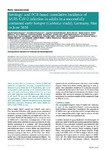Serology- and PCR-based cumulative incidence of SARS-CoV-2 infection in adults in a successfully contained early hotspot (CoMoLo study), Germany, May to June 2020
Santos-Hövener, Claudia
Neuhauser, Hannelore K.
Schaffrath Rosario, Angelika
Busch, Markus
Schlaud, Martin
Hoffmann, Robert
Gößwald, Antje
Koschollek, Carmen
Hoebel, Jens
Allen, Jennifer
Haack-Erdmann, Antje
Brockmann, Stefan
Ziese, Thomas
Nitsche, Andreas
Michel, Janine
Haller, Sebastian
Wilking, Hendrik
Hamouda, Osamah
Corman, Victor M.
Drosten, Christian
Schaade, Lars
Wieler, Lothar H.
CoMoLo Study Group
Lampert, Thomas
After a large church concert on 1 March 2020 and a first detected infection with severe acute respiratory syndrome coronavirus 2 (SARS-CoV-2) on 9 March, the southern German community of Kupferzell in the federal state Baden-Württemberg faced a steep increase of SARS-CoV-2 infections. Investigations of the local health authorities showed increasing evidence of community spreading in a complex and chronologically dense pattern of travel returnees who attended a choir and trombone church concert. Wide-reaching infection prevention and local control measures were implemented starting in the week of the first case detection, followed by additional measures such as a ban on gatherings in the federal state starting mid-March. The number of SARS-CoV-2 infections peaked in March but waned in April, and there were only three cases in May (Figure). There were three deaths, aged 59, 81 and 91 years. The cumulative incidence of 1,760 per 100,000 in Kupferzell by the end of April was, at the time of the study, one of the highest in Germany. The Robert Koch Institute (RKI) set out to analyse the SARS-CoV-2 seroprevalence in a random sample of this community from 20 May to 9 June.
Dateien zu dieser Publikation

